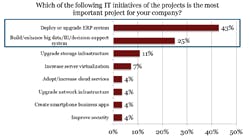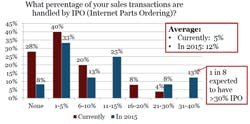AASA launched a new initiative in 2012 for the AASA Technology Council (ATC) to understand how information technology (IT) and business initiatives intersect. Part of this initiative was the survey conducted in August, “Aftermarket Supplier IT Spend & Trends,” which focused on suppliers’ IT budgeting and future developments in aftermarket technology.
Like this article? Sign up for our enews blasts here.
The findings, which were presented at the recent ATC Fall Conference, not only have implications for technology professionals but also identify potential opportunities for competitive advantages in the aftermarket.
IT Spend: Budget
According to the “IT Spend & Trends” survey respondents, their IT budgets as a percent of revenue typically range between 0-3 percent with almost half falling in the 1 percent to 2 percent range.
When compared with the findings from the Ernst & Young study, “Enterprise IT Investment Trends in 2012,” the aftermarket IT investment is greater than in other industries which only average between 0-1 percent.
These figures demonstrate how IT-driven the aftermarket is and demonstrates the industry’s key success factors. Aftermarket suppliers’ business is as much about fulfilling orders, meeting customer needs and assisting channel partners as it is about manufacturing processes, both of which are IT intensive.
Extending the comparison of the aftermarket to other industries, aftermarket suppliers’ IT spend is higher than those investments made in infrastructure and manufacturing. Not surprisingly, it is less than technology and financial services sectors. More surprising, aftermarket spending is as high as pharmaceuticals.
If aftermarket suppliers had been asked this question a decade ago, ERP would no doubt have been at the top of the list. This “one-time” expense appears to be a recurring spending need. “Big data” – the biggest technology priority for 25 percent of survey respondents – would not have made the list.
This question sparked much discussion among ATC Fall Conference attendees: “If your company is not spending on these priorities, should it be?”
IT Trends: IPO
One big trend revealed by the “IT Spend & Trends” survey was the role of e-commerce, which is driving change in the use of some aftermarket technology enablers. Suppliers expect the average percentage of sales handled by Internet part ordering protocol (IPO) to increase by more than 120 percent by 2015, although their percent of overall sales would only be expected to account for 12 percent of sales.
More significantly, one in eight survey respondents expect to have more than 30 percent of sales handled by IPO in 2015 – none are at that level now. The protocol is moving beyond its traditional role as just a special order tool.
The percentage of customers utilizing virtual inventory and EDI (electronic data interchange) also are projected to increase by 2015. While half of the suppliers participating in the survey currently do not employ virtual inventory, four out of five suppliers expect to utilize it with at least one of their customers by 2015. That reflects a big shift in just three years, moving virtual inventory from an uncommon capability to a standard or expected capability. Additionally, almost half of suppliers expect to have 80 percent or more of their sales go through EDI by 2015; only one in eight is at that level now.
As the e-tailing sector of the aftermarket continues to grow, respondents indicate that data standardization and accuracy will be one of the biggest challenges as e-tailing becomes a more integral part of the industry.
Technology is, and will continue to be, an integral part of an aftermarket suppliers strategy and the investments in IT show no sign of letting up soon. By utilizing IT more effectively, ATC conference attendees believed aftermarket executives could improve business performance and stay ahead of the curve in a crucial time in the industry.
Intersection of IT and Business
The ATC’s 2012 conference theme, “The Intersection of Technology and Business,” certainly reflects key “IT Spend & Trends” findings. Attendees’ comments indicated that IT spending is being driven by the imperatives of “meeting customer needs” and “integrating with customers.” The aftermarket business model is evolving, requiring a more integrated and cooperative value chain.
Given that technology increasingly drives business success in the aftermarket, it is worth examining how well IT is delivering on business priorities. Is aftermarket IT prepared to take advantage of the opportunities of the intersection of technology and business?
To answer this question, aftermarket technology professionals were asked to rate themselves on their business capabilities – and they rated themselves very highly. On a scale of 1 to 5, a majority of respondents rated themselves a 4 or a 5 on seven of the 10 business capabilities polled.
AASA compared its survey respondents’ self-assessment to a Forrester study of cross-industry business executives’ ratings of their IT organizations and staff on the same capabilities. This chart demonstrates the dramatic results – every single capability was “below the line” or in the gray triangle – meaning IT professionals rated themselves more highly than their business colleagues did.
This indicates there is considerable room to improve on helping technology and business intersect!
The areas of greatest disconnect were “manages cost” and “reviews projects with business sponsors.” The areas’ positioning on the chart – farthest from the line – means that IT professionals thought they were performing well, but business people think they’re performing very poorly. This could definitely be an area of increased friction as technology budgets continue to increase.
However, technology and business professionals agreed on one area for improvement: “collaborates with business on strategy.” Both rated this performance metric as mediocre. If the intersection of business and technology truly is vital for future aftermarket success, this is an area where improvement must happen.
Finally, both groups saw opportunity (through very low current ratings) in an “enterprise architecture that accommodates changes to business strategy.” A trend in cutting-edge strategic thinking is that maintaining “optionality” is key to success. Adaptability and flexibility are vital, especially in the current uncertain times. The ability to make IT adaptable to business strategy is an opportunity for competitive advantage for any company that can achieve it.
Key ‘IT Spend & Trends’ Takeaways
The key takeaways from the AASA “IT Spend & Trends” survey findings and the ATC discussions are:
- IT matters: the growth of e-commerce and e-tailing are changing aftermarket IT.
- IT drives competitive advantage: IT spending is increasing, despite challenging business and margin environment.
-
Aligning IT and business is a competitive advantage:
- The target is no longer about seeking best-in-class IT; it is about seeking advantage in the marketplace.
- IBM recently noted that by 2015, chief marketing officers will have larger IT budgets than chief operating officers.
- The respondents said it well: Meeting customer needs and integrating with customers are the business imperatives driving IT. IT is our business.
- This is a whole new frontier – both for business managers and IT executives – with big potential pay-offs.
Finally, these results hark back to AASA’s “Aftermarket Outlook 2020” report, which stated that aftermarket suppliers’ future success depends upon differentiated capabilities.
In the aftermarket, where the success factors are right part, right place, right time, information technology is essential to achieve a competitive advantage in cost or service. The caveat is: “Invest wisely.”
(Margaret Beck and Bailey Watson of AASA also contributed to this article.)
.gif?auto=format,compress&fit=max&q=45&w=250&width=250)





